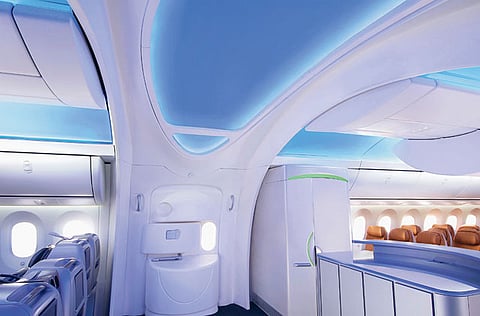Passion for quality: the stuff Dreamliners are made of
Boeing's new 787 designed for the total flying experience minus the jetlag

Dubai: How many of us are still fascinated with the magic of human flight? How many of us instead relate the experience of flying to stepping off a long flight feeling jetlagged and fatigued?
By combining its understanding of how the human body reacts to flight conditions and how emerging technologies can improve those conditions, Boeing is creating a better flying experience with its all-new 787 Dreamliner.
The company, along with universities from around the world, had embarked on numerous studies, while developing the Dreamliner, to understand the effects of altitude, humidity, air contaminants, lighting, sound and space on passengers.
In addition, Boeing studied how these factors play together to develop combinations to create the best overall experience. Findings have helped lead to significant improvements on the 787, which is due to be delivered in the last quarter of 2010.
Ride Quality: Providing a smoother flight
Passengers give higher ratings to flights that do not encounter turbulence. The 787 will have sensors installed on the airplane which cause certain control surfaces of the airplane to react in turbulence.
Altitude: How high is just right?
Today's airplanes are pressurised to a typical cabin altitude of 6,500 to 7,000 feet with a maximum certification altitude of 8,000 feet. The advanced composite materials used on the 787 are stronger than aluminum, allowing for the cabin to be pressurised to lower altitude levels without causing fatigue to the fuselage structure.
Humidity and Air Purification: Finding the best combination
In cooperation with the Denmark Technical University, Boeing challenged the assumption that simply increasing humidity would alleviate complaints about dryness on airplanes.
In fact, the most effective applied technology in reducing such symptoms is the introduction of a new gaseous filtration technology. Combining the technology with increased humidity offers increased passenger comfort and well-being. The improvements in cabin altitude combine with humidity and cleaner air to create a significant improvement in passenger comfort.
Windows: Offering a better view
Boeing surveyed passengers on their reaction to different window options. The results clearly show that passengers prefer larger windows. The 787 has larger windows than any of today's current commercial airplanes, offering passengers a commanding view of the horizon.
An altogether better flying experience
The 787 Dreamliner combines all of these pioneering new passenger features with unparalleled performance and advanced technology making the airplane as innovative inside as it is outside.
The result? An airplane that airlines can operate reliably and efficiently and one that their passengers will enjoy flying.
R. Blake Emery is Director of Differentiation Strategy at Boeing Commercial Airplanes
Sign up for the Daily Briefing
Get the latest news and updates straight to your inbox



